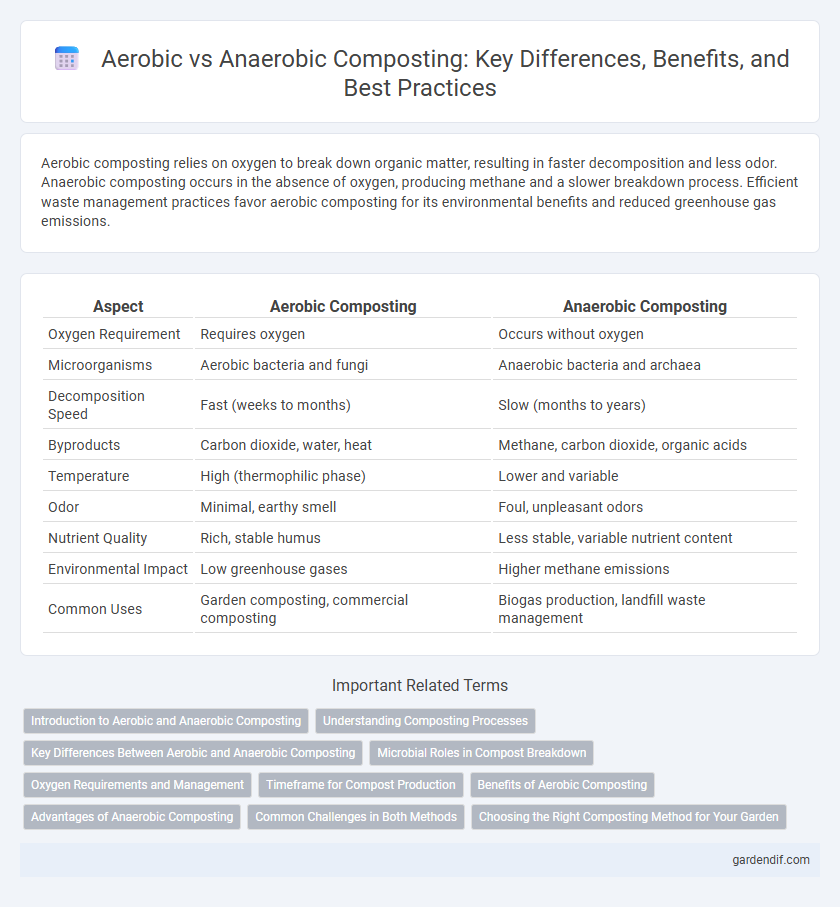
Aerobic composting vs Anaerobic composting Illustration
Aerobic composting relies on oxygen to break down organic matter, resulting in faster decomposition and less odor. Anaerobic composting occurs in the absence of oxygen, producing methane and a slower breakdown process. Efficient waste management practices favor aerobic composting for its environmental benefits and reduced greenhouse gas emissions.
Table of Comparison
| Aspect | Aerobic Composting | Anaerobic Composting |
|---|---|---|
| Oxygen Requirement | Requires oxygen | Occurs without oxygen |
| Microorganisms | Aerobic bacteria and fungi | Anaerobic bacteria and archaea |
| Decomposition Speed | Fast (weeks to months) | Slow (months to years) |
| Byproducts | Carbon dioxide, water, heat | Methane, carbon dioxide, organic acids |
| Temperature | High (thermophilic phase) | Lower and variable |
| Odor | Minimal, earthy smell | Foul, unpleasant odors |
| Nutrient Quality | Rich, stable humus | Less stable, variable nutrient content |
| Environmental Impact | Low greenhouse gases | Higher methane emissions |
| Common Uses | Garden composting, commercial composting | Biogas production, landfill waste management |
Introduction to Aerobic and Anaerobic Composting
Aerobic composting requires oxygen to break down organic materials, producing compost faster and emitting minimal odors due to efficient microbial activity. Anaerobic composting occurs in oxygen-deprived environments, resulting in slower decomposition and the release of methane and unpleasant odors. Understanding these processes helps optimize waste management strategies for environmental sustainability.
Understanding Composting Processes
Aerobic composting relies on oxygen to decompose organic waste through microbial activity, producing carbon dioxide, heat, and nutrient-rich humus. Anaerobic composting occurs in oxygen-free environments, generating methane, organic acids, and odors as byproducts due to anaerobic bacteria. Understanding these processes helps optimize compost quality and manage environmental impacts like greenhouse gas emissions.
Key Differences Between Aerobic and Anaerobic Composting
Aerobic composting requires oxygen and relies on aerobic microorganisms to decompose organic matter, resulting in faster breakdown and less odor. Anaerobic composting occurs without oxygen, utilizing anaerobic bacteria that produce methane and other gases, often leading to slower decomposition and stronger odors. Temperature levels differ significantly, with aerobic processes generating heat above 130degF, while anaerobic composting typically remains cooler.
Microbial Roles in Compost Breakdown
Aerobic composting relies on oxygen-dependent microbes such as bacteria and fungi to efficiently break down organic matter, producing nutrient-rich humus and minimal odors. Anaerobic composting involves microbes that thrive in oxygen-free environments, generating methane and other gases through slower decomposition processes. Understanding microbial roles in these composting methods is crucial for optimizing waste management and soil enrichment.
Oxygen Requirements and Management
Aerobic composting requires constant oxygen supply to sustain microbial activity, typically maintained through regular turning or forced aeration to optimize decomposition and minimize odor. Anaerobic composting occurs in oxygen-depleted environments, relying on facultative or anaerobic microbes, which often leads to slower breakdown and production of methane and unpleasant odors. Effective management of oxygen levels is crucial for aerobic systems, while anaerobic composting necessitates sealed conditions to limit oxygen exposure and control gas emissions.
Timeframe for Compost Production
Aerobic composting typically produces finished compost within 2 to 3 months due to the rapid breakdown of organic material by oxygen-dependent microbes. Anaerobic composting, relying on microorganisms in oxygen-free environments, often requires 6 months to over a year to fully decompose organic waste. The extended timeframe in anaerobic processes results from slower microbial activity and the production of methane and other gases during decomposition.
Benefits of Aerobic Composting
Aerobic composting accelerates organic matter decomposition by utilizing oxygen-dependent microorganisms, resulting in faster nutrient recycling compared to anaerobic composting. This process produces less methane, a potent greenhouse gas, thereby reducing environmental impact and enhancing soil health. The higher temperatures reached during aerobic composting also effectively eliminate pathogens and weed seeds, promoting safer and more nutrient-rich compost for agricultural use.
Advantages of Anaerobic Composting
Anaerobic composting produces biogas, a valuable renewable energy source, through the breakdown of organic matter in oxygen-free environments. This method significantly reduces odors and greenhouse gas emissions compared to aerobic composting, making it environmentally advantageous. It also requires less frequent turning and maintenance, resulting in lower labor costs and operational simplicity.
Common Challenges in Both Methods
Both aerobic and anaerobic composting face challenges such as odor control, maintaining optimal moisture levels, and managing temperature fluctuations to ensure efficient decomposition. Inadequate aeration in aerobic composting can lead to anaerobic pockets, while anaerobic composting often struggles with slow breakdown and methane emission. Effective management of these factors is crucial for minimizing environmental impact and maximizing nutrient-rich compost output.
Choosing the Right Composting Method for Your Garden
Aerobic composting uses oxygen to break down organic waste rapidly, producing nutrient-rich humus and minimal odor, making it ideal for garden beds requiring quick soil enrichment. Anaerobic composting occurs without oxygen, generating methane and stronger odors, but it suits large-scale waste reduction where odor control is less critical. Selecting the right method depends on garden size, odor tolerance, and desired composting speed.
Aerobic composting vs Anaerobic composting Infographic

 gardendif.com
gardendif.com